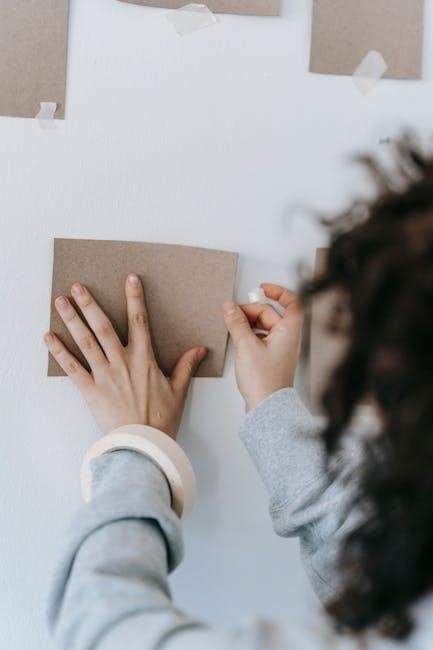Plantar fasciitis is a common condition causing heel pain, often due to inflammation of the plantar fascia. Taping techniques, like Low-Dye and Kinesio, are widely used to alleviate symptoms and provide support, offering a non-invasive approach to managing this condition effectively.
1.1 Definition of Plantar Fasciitis
Plantar fasciitis is a condition characterized by inflammation of the plantar fascia, a thick band of connective tissue supporting the arch of the foot. It typically results from repetitive strain or microtears in the fascia, leading to pain and stiffness, especially in the heel. This condition is often associated with degenerative changes in the collagen fibers, rather than acute inflammation, and is a common cause of heel pain in both active and sedentary individuals. Symptoms often worsen with initial weight-bearing activities.
1.2 Overview of Taping as a Conservative Treatment
Taping is a widely recognized conservative treatment for plantar fasciitis, offering immediate support and pain relief. Techniques like Low-Dye and Kinesio taping are commonly employed to off-load the plantar fascia, reducing strain and promoting healing. By altering foot mechanics, taping helps distribute pressure more evenly, alleviating discomfort during activities. It is a non-invasive, cost-effective option often used alongside other therapies, making it a popular choice for managing symptoms in both acute and chronic cases of plantar fasciitis.
Causes and Symptoms of Plantar Fasciitis
Plantar fasciitis is often caused by inflammation of the plantar fascia, linked to biomechanical stress. Common symptoms include heel pain, tenderness, and stiffness, especially after rest.
2.1 Biomechanical Factors Contributing to Plantar Fasciitis
Biomechanical factors such as altered gait patterns, excessive pronation, and tight Achilles tendons contribute to plantar fasciitis. These factors increase stress on the plantar fascia, leading to microtears and inflammation. Overuse and improper footwear can exacerbate these issues. Taping techniques help address these biomechanical imbalances by providing structural support and redistributing stress, thereby reducing strain on the fascia and promoting healing. Understanding these factors is crucial for effective management and prevention of the condition.
2.2 Common Symptoms and Pain Patterns
Plantar fasciitis typically presents with sharp or dull heel pain, often worse with the first steps of the day or after prolonged rest. Pain is usually localized to the medial tubercle of the calcaneus but may radiate along the arch. Symptoms can vary in intensity, with some individuals experiencing tenderness or stiffness. Activities like walking or standing for long periods may exacerbate discomfort. The pain often improves with movement but can return after extended activity. Early recognition of these patterns is essential for effective management.

Taping Techniques for Plantar Fasciitis
Various taping methods, such as Low-Dye, Calcaneal, and Kinesio taping, are used to support the plantar fascia, reduce strain, and alleviate pain during daily activities.
Low-Dye taping is a widely recognized technique for managing plantar fasciitis. It involves applying athletic tape around the heel and arch, with specific tension to off-load the plantar fascia. This method reduces strain on the fascia, providing immediate pain relief. Application typically starts at the heel, wraps around the foot, and finishes at the metatarsals. Proper technique ensures optimal support and comfort, making it a popular choice for short-term symptom management. Regular reapplication is often necessary for sustained benefits. Calcaneal taping targets the heel bone to alleviate pain associated with plantar fasciitis. This method involves placing tape around the calcaneus to stabilize and support the area. The tape is applied in a figure-eight pattern, starting from the back of the heel, wrapping around the sides, and securing at the bottom. This technique helps reduce stress on the plantar fascia by redistributing pressure, offering both pain relief and enhanced stability during movement. Proper application ensures maximum effectiveness and comfort for the patient. Kinesio taping aims to relieve pain and inflammation in plantar fasciitis by promoting lymphatic drainage and reducing tension on the plantar fascia. Applied with light tension, the tape lifts the skin to enhance blood flow and minimize swelling. This method supports natural movement, allowing full range of motion while providing stability. Its benefits include reduced pain, improved function, and accelerated recovery. Kinesio taping is often combined with other therapies, such as ultrasound or stretching, to enhance its effectiveness in managing plantar fasciitis symptoms. Taping redistributes pressure and stabilizes the foot, reducing strain on the plantar fascia. It provides mechanical support, alleviating stress and promoting healing in the affected tissues. Off-loading techniques, such as taping, reduce stress on the plantar fascia by redistributing pressure. This method alleviates tension, especially during activities like walking, helping to minimize pain and inflammation. The tape supports the arch and heel, preventing excessive stretching of the fascia. By limiting movement in these areas, taping creates a protective environment, allowing the plantar fascia to heal. This approach is particularly effective in the short term for managing symptoms and improving mobility. Taping techniques can modify foot mechanics by redistributing pressure and stabilizing the foot during movement. Low-Dye taping, for example, supports the arch and restricts excessive pronation, while Calcaneal taping stabilizes the heel. These methods help correct abnormal gait patterns and reduce strain on the plantar fascia. By altering foot mechanics, taping can improve weight distribution and reduce discomfort, providing immediate relief and enhancing functional mobility for individuals with plantar fasciitis. This approach complements other treatments to address the root causes of the condition. Taping techniques, such as Low-Dye and Calcaneal, have shown short-term effectiveness in reducing pain and improving function for plantar fasciitis patients, supported by clinical studies. Studies indicate that taping techniques, such as Low-Dye and Kinesio, provide significant short-term pain relief and functional improvement for plantar fasciitis patients. These methods reduce strain on the plantar fascia, offering immediate support and comfort. Research shows that taping can alleviate morning pain and enhance mobility, allowing patients to resume daily activities more effectively. The short-term benefits of taping make it a valuable conservative treatment option for managing heel pain and improving quality of life. Research compares various taping techniques for plantar fasciitis, with Low-Dye and calcaneal methods showing the most effectiveness. Low-Dye taping is favored for its ability to off-load the plantar fascia, while calcaneal taping focuses on heel support. Kinesio taping, emphasizing gentle compression, promotes lymphatic drainage and flexibility. Studies suggest that Low-Dye taping often yields superior short-term pain relief, though individual responses vary. Each method has its benefits, and the choice depends on patient-specific needs and biomechanical factors. Apply hypoallergenic tape starting with anchor points around the heel. Stretch the foot gently, wrap the arch, and secure the tape without excessive tension for optimal support. Use hypoallergenic athletic tape, scissors, and optional padding for sensitive areas. Clean and dry the foot, removing oils or lotions. Trim excess hair to ensure better adhesion. Apply anchor strips around the heel and forefoot for stability. Ensure the tape is not too tight, as this can cause discomfort or restrict movement. Proper preparation enhances the effectiveness of the taping technique and prevents skin irritation or allergic reactions during application.3.1 Low-Dye Taping: Definition and Application
3.2 Calcaneal Taping: Purpose and Methodology
3.3 Kinesio Taping: Principles and Benefits
How Taping Provides Support and Reduces Stress
4.1 Off-Loading the Plantar Fascia
4.2 Altering Foot Mechanics Through Taping

Effectiveness of Taping in Managing Plantar Fasciitis
5.1 Short-Term Pain Relief and Functional Improvement
5.2 Comparison of Different Taping Methods

Step-by-Step Guide to Applying Taping Techniques
6.1 Materials and Preparation
6.2 Proper Taping Application for Maximum Support
Apply the tape with moderate tension, starting from the heel and wrapping around the foot. Ensure even pressure distribution to off-load the plantar fascia. Smooth the tape firmly to avoid wrinkles. Apply anchor strips at the heel and forefoot for added stability. Finish with a final layer of tape to secure all edges, providing maximum support without restricting movement. Proper application ensures effectiveness and comfort, helping to alleviate pain and stress on the plantar fascia during daily activities.
Taping for Plantar Fasciitis: Tips and Precautions
Use hypoallergenic tape to minimize skin irritation. Apply gently to avoid tightness. Remove carefully to prevent skin damage. Ensure proper technique to maximize support and comfort.
7.1 Common Mistakes to Avoid During Application
Overstretching the tape can cause discomfort and reduce effectiveness. Avoid applying tape too tightly, as it may restrict movement or cause skin irritation. Ensure the foot is clean and dry before taping to prevent slipping. Using the wrong type of tape or improper alignment can lead to poor support. Applying tape without proper preparation or after shaving can increase the risk of skin reactions. Always follow a qualified professional’s guidance for optimal results and to minimize complications.
7.2 Skin Care and Allergy Considerations
Proper skin care is essential when using taping for plantar fasciitis. Clean and dry the skin thoroughly before application to ensure tape adhesion and prevent irritation. Avoid using lotions or oils, as they can weaken the tape’s grip. If you have sensitive skin, perform a patch test for allergies to the adhesive. Remove tape gently to avoid skin damage. If irritation occurs, discontinue use and consider alternative methods. Moisturize after removal to maintain skin health.
Combining Taping with Other Treatments
Taping can be combined with orthotics, stretching exercises, ice therapy, and anti-inflammatory medications for a comprehensive approach to managing plantar fasciitis, enhancing recovery and pain relief.
8.1 Orthotics and Stretching Exercises
Orthotics, such as arch supports, can complement taping by redistributing pressure and correcting foot mechanics. Stretching exercises target the plantar fascia and Achilles tendon, improving flexibility and reducing tension. Combining these with taping enhances support and promotes long-term healing. Regular stretching routines, including calf stretches and toe curls, are recommended to alleviate symptoms and prevent recurrence. This multimodal approach addresses both the immediate pain and underlying causes of plantar fasciitis, fostering a faster recovery process for patients.
8.2 Ice Therapy and Anti-Inflammatory Medications
Ice therapy helps reduce swelling and pain by constricting blood vessels and numbing the area. Applying ice packs to the heel for 10-15 minutes, several times daily, can provide immediate relief. Anti-inflammatory medications, such as ibuprofen, further aid in reducing pain and inflammation. These methods, when combined with taping, enhance comfort and accelerate healing. They are particularly effective in the acute phase of plantar fasciitis, offering a comprehensive approach to managing symptoms and supporting recovery.
Taping techniques, such as Low-Dye and Kinesio, have shown efficacy in managing plantar fasciitis by reducing pain and stress on the plantar fascia. Further research is needed to explore long-term effects and optimize taping methods for sustained relief.
9.1 Summary of Taping Efficacy
Taping techniques, such as Low-Dye and Kinesio, have demonstrated significant short-term efficacy in reducing pain and stress on the plantar fascia. These methods provide immediate mechanical support, improving functional mobility and alleviating discomfort. Systematic reviews highlight their effectiveness in managing symptoms, with Low-Dye taping being particularly favored. While taping offers a non-invasive and cost-effective solution, further research is essential to determine long-term benefits and optimize application methods for sustained relief in plantar fasciitis patients.
9.2 Need for Further Research on Long-Term Effects
While taping techniques show promise for short-term pain relief, limited research exists on their long-term efficacy. Most studies focus on immediate symptom reduction, leaving gaps in understanding sustained benefits. Factors such as tape durability, patient adherence, and potential skin reactions over extended periods require investigation. Additionally, comparative studies between different taping methods could optimize treatment protocols. Future research should address these aspects to establish taping as a reliable long-term solution for plantar fasciitis management.

References and Additional Resources
Key studies include Saxelby et al. and systematic reviews on taping efficacy. Recommended reading materials cover Kinesio taping, Low-Dye techniques, and plantar fasciitis management strategies.
10.1 Key Studies and Systematic Reviews
Studies by Saxelby et al. (1997) and systematic reviews highlight the efficacy of Low-Dye taping in reducing plantar fascia strain. Research on Kinesio taping demonstrates its benefits in pain reduction and fascial support. A systematic review with a Standardized Mean Difference (SMD) of 0.47 (95% CI 0.05 to 0.88) supports taping’s effectiveness. These studies provide evidence for taping as a conservative treatment, emphasizing its short-term benefits and varying patient responses.
10.2 Recommended Reading Materials
Recommended materials include the Ares booklet on taping methods for orthopedic symptoms and clinical studies from clinmedjournals.org. The article “Foot Ankle 1987” by A.P. Середа provides foundational insights. Additional resources like “International Journal of Foot and Ankle” offer in-depth analyses. These materials are essential for understanding taping techniques, their applications, and evidence-based outcomes, serving as valuable references for both practitioners and patients seeking comprehensive guides on managing plantar fasciitis through taping.
